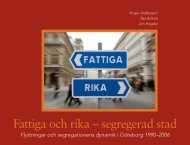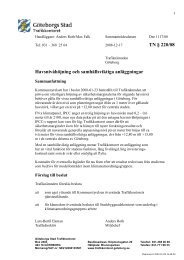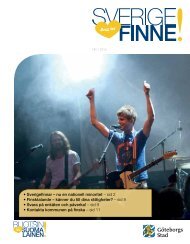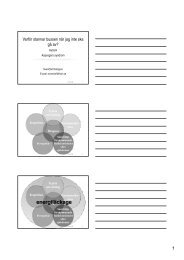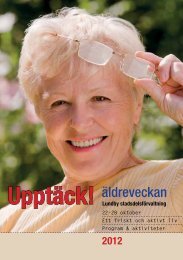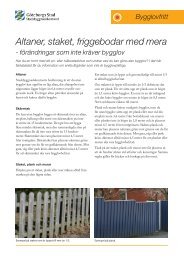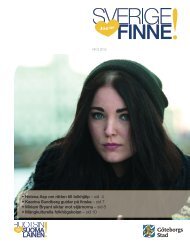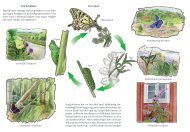Skiascope 1 som pdf - Göteborg
Skiascope 1 som pdf - Göteborg
Skiascope 1 som pdf - Göteborg
Create successful ePaper yourself
Turn your PDF publications into a flip-book with our unique Google optimized e-Paper software.
utnyttja. Han försökte också reglera ljusinsläppen från takfönstren<br />
med ”vela”. 36 Av fotografier att döma var det både frågan om baldakinliknande<br />
arrangemang ( salen väster om trapphuset), utdragbara<br />
gardiner ( takfönstren i skulptursalarna på tredje våningen) och<br />
uppspända, vinklade dukar ( trapphuset).<br />
Allt måleri hängde inte i Konstavdelningen. Även i de så kallade<br />
Högreståndsinteriörerna i den Historiska avdelningen fanns många<br />
målningar, men till skillnad från i konstsamlingarna betonades inte<br />
deras estetiska värde. Det gäller även andra målningar och teckningar<br />
<strong>som</strong> museet samlade av historiska skäl. En liknande differentiering<br />
gjordes senare när marinmåleriet skiljdes ut och placerades på Sjöfartsmuseet.<br />
Konstmuseer har nästan alltid heterogena samlingar. De innehåller<br />
verk i olika tekniker, från olika tider och konstnärer, av olika storlek,<br />
färg och form. Endast i undantagsfall har museerna beställt verk<br />
av konstnärer för att hänga i särskilda rum, till skillnad från större<br />
privata och furstliga samlingar där detta inte är ovanligt. För att motverka<br />
det disparata uttrycket grupperar och arrangerar museer verken<br />
efter specifika estetiska principer, exempelvis färgkorrespondenser<br />
och rytmiska grupperingar. Färgsättningen av väggarna anpassas<br />
ofta efter de verk <strong>som</strong> salarna är avsedda att inrymma, åtminstone<br />
fram till senmodernismens vita eller beige rum. Det har också varit<br />
vanligt att målningarna ramats om för att ge ett mer enhetligt intryck<br />
( ett bruk <strong>som</strong> varit vanligt hos privatsamlare sedan renässansen). Vid<br />
Altes Museum i Berlin designade arkitekten Karl Friedrich Schinkel<br />
stilhistoriskt passande ramar för samlingarna. 37 I <strong>Göteborg</strong> förefaller<br />
konstnären Geskel Saloman ha tillverkat ramar för Konstföreningen<br />
från och med 1858, varav några fortfarande finns i museets ägo. 38<br />
Det hängningssystem <strong>som</strong> vid tiden rådde på så gott <strong>som</strong> samtliga<br />
museer och publikt tillgängliga privatsamlingar arbetade efter<br />
två axlar: kronologi och attribution. Målningar av samma konstnär,<br />
skola och från samma land grupperades tillsammans, och vandringen<br />
i salarna följde ett i stort sett ett kronologiskt upplägg. Detta<br />
konsthistoriska paradigm hade under 1700-talets mitt börjat ersätta<br />
ett tidigare sätt att arrangera konstverken där man strävade efter<br />
kontrastverkan. 39 En målning av till exempel Rubens kunde då<br />
hängas bredvid en av Poussin. Måleriska effekter kontrasterades då<br />
mot teckning och komposition. Skillnaden mellan hängningarna kan<br />
74<br />
75<br />
exploit. He also experimented with adjusting the light from the skylights<br />
using ‘vela’, or sail-like arrangements. 36 From the photographs, he seems<br />
not to have stopped there, employing baldachins ( the gallery west of the<br />
stair ), blinds ( the skylights in the sculpture gallery on the third floor ), and<br />
scrims ( stretched, angled cloths used in the stairwell ).<br />
Not all the paintings were hung in the department of art. Even the<br />
so-called upper-class interiors over in the museum’s department of history<br />
displayed a number of paintings, but unlike those in the art collections,<br />
the emphasis was not on their aesthetic qualities. This was true of the<br />
other paintings and drawings that the museum had collected for historical<br />
reasons. A similar differentiation was made later when the marine painting<br />
was separated out and placed at the Maritime Museum.<br />
The collections held at museums of art are nearly always heterogeneous.<br />
They contain works of different techniques, from different periods<br />
and artists, of different sizes, colours, and forms. Only in exceptional<br />
cases did museums commission work direct from the artist to hang in<br />
specific spaces, unlike the larger private and royal collections where this<br />
was very much the norm. In order to counteract the disparate impression<br />
their collections create, museums group works according to specific<br />
aesthetic principles such as colour correspondence or rhythm. The colour<br />
of the gallery walls is often chosen to suit the works that are to be hung<br />
there, or so was the case until the rise of the all-white or beige room of late<br />
Modernism. It was also common for paintings to be reframed in order to<br />
give a more unified impression ( a standard practice amongst private collectors<br />
since the Renaissance ). At the Altes Museum in Berlin, the architect<br />
Karl Friedrich Schinkel designed historically appropriate frames for<br />
the collections. 37 In Gothenburg it seems that the artist Geskel Saloman<br />
made frames for the Society of Art, beginning in 1858, of which several<br />
remain in the museum’s possession. 38<br />
The system of hanging artworks then customary in most museums<br />
– and the private collections that were open to the pubic – operated along<br />
on two axes : chronology and attribution. Paintings of the same artist,<br />
school, and country were grouped together, and the visitor’s progression<br />
around the rooms was designed to follow a broadly chronological<br />
sequence. This was the historical paradigm that in the middle of the eighteenth<br />
century had begun to replace the previous method of arranging art,<br />
which had aimed for contrasting effects. 39 Under to the older disposition,<br />
a Rubens might well be hung next to a Poussin; painterly effects were



